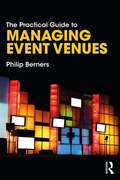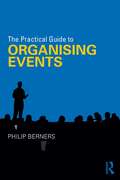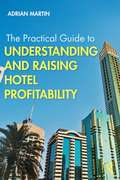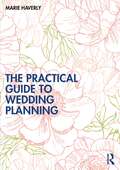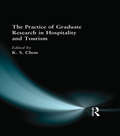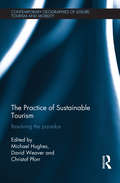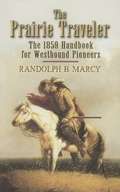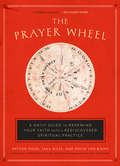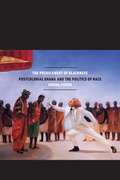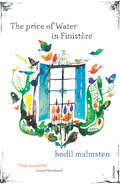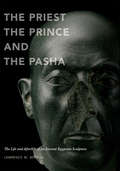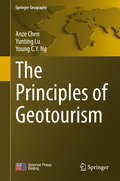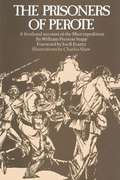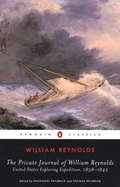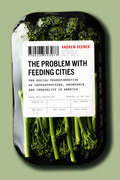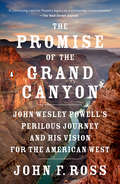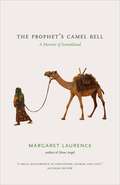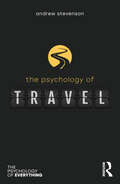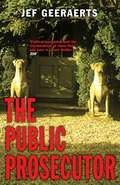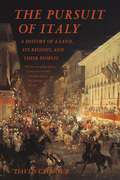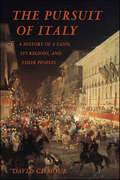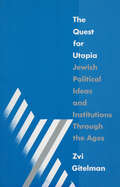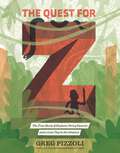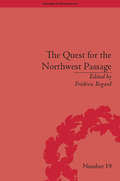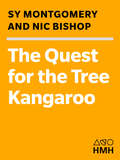- Table View
- List View
The Practical Guide to Managing Event Venues
by Philip BernersThis is a short, accessible and practical guide to running venues which are in the business of hosting events. Using honest guidance peppered with the author’s real-life situational anecdotes to contextualise the topics, the book is logically structured around the key stages of event management: pre-event, onsite and post-event. Topics covered include developing the client relationship, marketing, financial accountability, risk, interdepartmental communication, onsite procedures and post-event evaluation. This is a fundamental resource for all event management and hospitality students. It is also a book for anybody who manages a venue or is a venue event manager. The Practical Guide to Managing Event Venues makes the business of venue management appealing, understandable and achievable.
The Practical Guide to Organising Events (The Practical Guide to Events and Hotel Management Series)
by Philip BernersThe Practical Guide to Organising Events is a short, accessible and practical guide on how to successfully plan and organise a variety of event types in a wide range of contexts. The core sections of the text are logically structured around the key stages of event management – pre-event, on-site and post-event – offering essential practical insight and guidance throughout the whole process. Topics covered include proposal writing, budget, funding and sponsorship, health and safety, security and evaluation. This is a fundamental resource for all events management students running and organising an event as part of their degree programme. It is also a book for anybody who just happens to be tasked with organising an event such as an office party, a social networking event, Christmas party or family wedding. Based on experience, using real-life case studies and anecdotal examples, The Practical Guide to Organising Events ultimately makes the business of events management appealing, understandable and achievable.
The Practical Guide to Understanding and Raising Hotel Profitability (The Practical Guide to Events and Hotel Management Series)
by Adrian MartinThe Practical Guide to Understanding and Raising Hotel Profitability offers a comprehensive, easy-to-follow breakdown of how to understand profit and loss accounts for hotels. It offers practical advice on how to maximise the profits of this customer-facing business and improve performance results. Chapters cover every aspect of the profit and loss account including marketing, accommodation, food and beverage sales, quality, budgeting, event sales, and all the corresponding costs involved. It explains all the relevant KPIs and industry quirks within the profit and loss document as well as industry benchmarks to equip the reader with the skills to attend high level meetings, complete finance-based assignments and ultimately run their own business. Valuable tips from leading professionals within the industry are included throughout, giving advice on how to improve hotels’ financial results and positively influence net profit through everyday actions. Packed full of practical case studies and written in an easy-to-read-style, this book is essential reading for hospitality students and current hospitality and hotel managers.
The Practical Guide to Wedding Planning
by Marie HaverlyThis concise yet comprehensive guide offers highly practical insights and advice to those wanting to plan weddings as a career choice. Chapters take the reader through all the essential steps to creating the perfect wedding, including the clients, budgeting, the venue, the ceremony, food and beverages, stationery and so on. The many business aspects of starting a career in wedding planning are also covered, including marketing and pricing strategy. Written in an engaging and highly accessible style, this guide assumes no prior knowledge of the industry and is ideal for those just starting their careers. Packed full of case studies, activities, example forms, timetables, calendars and helpful checklists, this is a guide that readers will undoubtedly come back to again and again as they gain more experience in the world of wedding planning. Written by a highly experienced ex-wedding planner, this will be invaluable reading for those looking to enter or progress in the world of wedding planning, those already working in the industry, studying an events management programme, or perhaps looking for a career change.
The Practice of Graduate Research in Hospitality and Tourism
by Kaye Sung ChonImprove your hospitality and tourism research abilities with this impressive collection of research methods! The Practice of Graduate Research in Hospitality and Tourism assists you in gaining insight into different facets of research design, conceptual development, research methods, and conclusions drawn from research in hospitality and tourism. As a professional, researcher, or graduate student in the hospitality and tourism field, you will benefit from this collection of chapters that represent examples of research trials conducted by graduate students in hospitality and tourism and are selected on the basis of the originality of the students’concepts, research methods, and interest of the work to graduate students. This informative volume will provide you and your students with up-to-date and effective ideas for researching topics within the field of hospitality. The Practice of Graduate Research in Hospitality and Tourism is an excellent supplemental textbook for research methods classes in graduate hospitality and tourism programs. The wide variety of chapters will stimulate discussions on research in hospitality and tourism from conceptual, secondary data, and primary data approaches. Some of the research articles you will explore in The Practice of Graduate Research in Hospitality and Tourism are based on different statistical techniques, research designs, and trends of subjects. Topics include: selecting service-oriented employees based on person-organization fit measuring the effectiveness of advertising on the Internet examining factors that affect food expenditures of U.S. tourists when they are away from home explaining the competitive structure of Japanese travelers’overseas destination plans determining the motivational needs of managers in the on-site foodservice segment providing adequate education on HIV and AIDS in the workplace for hospitality managers identifying influential variables of employee turnover in the food and beverage industryThe Practice of Graduate Research in Hospitality and Tourism serves as an important forum for initiating research and new ideas internationally. The carefully selected chapters of this essential text will provide you and your students with suggestions that will improve research competency as well as hospitality services to patrons.
The Practice of Sustainable Tourism: Resolving the Paradox (Contemporary Geographies of Leisure, Tourism and Mobility)
by Michael Hughes David Weaver Christof PforrSustainable tourism is a widely used term that has accumulated considerable attention from researchers and policy makers over the past two decades. However, there is still an apparently wide gap between theory and practice in the area. Recent scholarly research has tended to focus on niche areas of alternative tourism rather than address the broader issues and vagaries and paradoxes that appear to plague the broader notion of sustainable tourism. As such, there is a need for a new and pragmatic analysis of sustainable tourism as an overarching idea and how this manifests in practice. The Practice of Sustainable Tourism fulfils this need by offering a fresh perspective on sustainable tourism as an umbrella concept with inherent tensions. It presents a way of thinking about tourism based on the notion of finding common ground using the dialectic tradition of philosophy. Dialectics focusses on resolving opposing viewpoints by recognising they have common elements that can be combined into a rational and practical solution over time. As part of this approach, the book examines the strongly apparent tensions within alternative tourism as well as the paradox of continuing growth and other mass tourism related issues. It is divided into three parts, Part I includes chapters discussing the general concept of sustainable tourism, its history, current status and possible futures; Part II includes a range of destination case studies exploring how sustainable tourism has been applied and Part III includes perspectives from the tourism operator view. Given the international content and challenging themes, the book will be appealing internationally to students, researchers and academics in the fields of tourism, geography, sustainability and social science.
The Prairie Traveler: The 1859 Handbook for Westbound Pioneers
by Randolph B. MarcyAlong with a good rifle and a sturdy horse, this guidebook was essential for westward-bound pioneers. Originally published by the War Department, Capt. Marcy's manual offers life-or-death advice on choosing the best routes to California, food supplies, treating snakebites, fording rivers, and encountering Native Americans.
The Prayer Wheel: A Daily Guide to Renewing Your Faith with a Rediscovered Spiritual Practice
by Jana Riess Patton Dodd David Van BiemaAward-winning religion journalists describe a recently rediscovered medieval prayer tool that provides fresh inspiration and daily prayers for contemporary Christians.All people of faith struggle at times to sustain a flourishing prayer life--a loss felt all the more keenly in times like ours of confusion, political turbulence, and global calamity. The Prayer Wheel introduces an ancient prayer practice that offers a timeless solution for the modern faithful.The Prayer Wheel is a modern interpretation of the Liesborn Prayer Wheel, a beautiful, almost wholly forgotten, scripture-based mode of prayer that was developed in a medieval times. The Liesborn Prayer Wheel resurfaced in 2015 in a small private gallery near New York's Metropolitan Museum of Art. It faithfully and beautifully presents seven prayer paths for personal or group use. Each path invites contemplation on the "big ideas" of the Christian faith--the Lord's Prayer, the Beatitudes, the gifts of the Holy Spirit, and key words from the life of Christ.In the tradition of lectio divina and walking a labyrinth, The Prayer Wheel simply and directly takes readers into a daily, wholly unique encounter with God. As the prayers in this book unfold, readers will find an appealing guide for contemplation, a way of seeing God in new ways, and an essential new tool for Christian formation.
The Predicament of Blackness: Postcolonial Ghana and the Politics of Race
by Jemima PierreWhat is the meaning of blackness in Africa? While much has been written on Africa's complex ethnic and tribal relationships, Jemima Pierre's groundbreaking The Predicament of Blackness is the first book to tackle the question of race in West Africa through its postcolonial manifestations. Challenging the view of the African continent as a nonracialized space--as a fixed historic source for the African diaspora--she envisions Africa, and in particular the nation of Ghana, as a place whose local relationships are deeply informed by global structures of race, economics, and politics. Against the backdrop of Ghana's history as a major port in the transatlantic slave trade and the subsequent and disruptive forces of colonialism and postcolonialism, Pierre examines key facets of contemporary Ghanaian society, from the pervasive significance of "whiteness" to the practice of chemical skin-bleaching to the government's active promotion of Pan-African "heritage tourism. " Drawing these and other examples together, she shows that race and racism have not only persisted in Ghana after colonialism, but also that the beliefs and practices of this modern society all occur within a global racial hierarchy. In doing so, she provides a powerful articulation of race on the continent and a new way of understanding contemporary Africa--and the modern African diaspora.
The Price of Water in Finistère
by Bodil Malmsten'In the same way as there's a partner for every person, there's a place. All you have to do is find the one that's yours among the billions that belong to someone else, you have to be awake, you have to choose.' With this conviction in mind, acclaimed Swedish writer Bodil Malmsten abandons her native country at the age of fifty-five and settles in Brittany. At the heart of this memoir is the conviction that the happiness to be found in Finistère will not allow itself to be, cannot be, expressed in writing. Embroidered around this seeming paradox are poignant, outraged and thought-provoking observations on the widest range of subjects: how not to buy plants, the elicit pleasures of bargain-hunting, the misery of writer's block, social democracy, racism, tulipomania, the stubbornness of bank managers, the controlling of moles and slugs, death, political hypocrisy, the delights of wild weather. Malmsten's passion and humour shine through every episode she describes, however minor, offering the reader a window onto a solitary life at once touching, thought-provoking and, occasionally, hilarious.
The Priest, The Price, And The Pasha
by Lawrence M. BermanSometime in the early fourth century BC, an unknown Egyptian master carved an exquisite portrait in dark-green stone. The statue that included this head of a priest, likely a citizen of ancient Memphis, may have been damaged when the Persians conquered Egypt in 343 BC, before it was buried in a temple complex. Its adventures were not over: after almost two millennia, the head was excavated by Auguste Mariette, a founding figure in French archaeology. Sent to France as part of a collection assembled for the inimitable Bonaparte prince known as Plon-Plon, it found a home in his faux Pompeian palace. After disappearing again, it resurfaced in the collection of American aesthete Edward Perry Warren, who donated it to the MFA, Boston. Along the way, this compelling, mysterious sculpture has reflected the evolving understanding of Egyptian art.
The Principles of Geotourism
by Anze Chen Yunting Lu Young C. Y. NgThe book introduces tourism earth-science as a new scientific discipline by applying the principles of earth-science in the study of natural and human tourism resources. It involves studying the geo-scientific characteristics of these tourism resources through surveys, evaluation and aesthetic value assessment. It also discusses about the principles behind geopark establishment and management. It is an important publication providing direction for geopark and tourism developments in China. The book is a tool for geological heritage survey, assessment and research. It can also be used to assist planning of geopark, national parks, heritage protection and scientific interpretation. It is a valuable teaching material for teachers and students of geoscience and tourism as well as providing useful guidance for geopark managers and tour guides in their operation. In addition, the book also offers scientific knowledge of the surrounding natural and cultural landscapes to the public and the general visitors.
The Prisoners of Perote
by William Preston StappIn late 1842, Private William Preston Stapp and about three hundred other citizens of the Republic of Texas took it upon themselves to invade Mexico. They intended to retaliate for a recent Mexican attack on San Antonio and to humiliate President Sam Houston, who had been hesitant to seek revenge. Stapp provides a closely observed, day-by-day narrative of the disastrous adventure later known as the Mier expedition. While his style might be described as "elegantly restrained" in comparison to the literary excesses of that early Victorian age, Stapp''s flair for drama and description makes for colorful reading. In response to the public outrage prompted by the San Antonio incident, Houston issued a presidential proclamation inviting volunteers for a retaliatory expedition across the Rio Grande. After the bloodless "capture" and pillage of two Mexican border towns, he called the volunteers back home. Most were relieved to comply, but some felt compelled to pursue the honor of the Republic further, and the Mier expedition was launched on December 20, 1842. On the day after Christmas, all save a forty-man camp guard were captured outside of Mier, a few miles across the Mexican border. The prisoners faced a brutal forced march to Mexico City. Stapp was one of a large group that escaped along the way, became lost in the mountains, and suffered badly from hunger and thirst before recapture. He survived the notorious Black Bean Episode in which 17 of the 176 returned escapees were shot after drawing black beans in a lottery. The Texans were delivered to Perote Prison near Mexico City in September 1843, where a few of them tunneled to freedom and many more died in captivity. Mexico released the last of the prisoners in 1844, and Stapp was among them. First published in 1845 and later issued in pamphlet form in 1933 by the La Grange Journal, The Prisoners of Perote is a fascinating view of a painful episode in Texas history. The foreword by Joe B. Frantz provides a perspective on the Texas-Mexico relations during this period "when both countries were shaking down and had not yet found their way. " He points out that The Prisoners of Perote provides some clues to the reasons behind the inherent tenseness that exists between Texas and Mexico today. In late 1842, Private William Preston Stapp and about three hundred other citizens of the Republic of Texas took it upon themselves to invade Mexico. They intended to retaliate for a recent Mexican attack on San Antonio and to humiliate President Sam Houston, who had been hesitant to seek revenge. Stapp provides a closely observed, day-by-day narrative of the disastrous adventure later known as the Mier expedition. While his style might be described as "elegantly restrained" in comparison to the literary excesses of that early Victorian age, Stapp''s flair for drama and description makes for colorful reading. In response to the public outrage prompted by the San Antonio incident, Houston issued a presidential proclamation inviting volunteers for a retaliatory expedition across the Rio Grande. After the bloodless "capture" and pillage of two Mexican border towns, he called the volunteers back home. Most were relieved to comply, but some felt compelled to pursue the honor of the Republic further, and the Mier expedition was launched on December 20, 1842. On the day after Christmas, all save a forty-man camp guard were captured outside of Mier, a few miles across the Mexican border. The prisoners faced a brutal forced march to Mexico City. Stapp was one of a large group that escaped along the way, became lost in the mountains, and suffered badly from hunger and thirst before recapture. He survived the notorious Black Bean Episode in which 17 of the 176 returned escapees were shot after drawing black beans in a lottery. The Texans were delivered to Perote Prison near Mexico City in September 1843, where a few of them tunneled to freedom and many more died in captivity. Mexico released the last of the prisoners in 1844, and Stapp was among them. First published i...
The Private Journal of William Reynolds
by Nathaniel Philbrick Thomas Philbrick William ReynoldsOne of the finest nineteenth-century first-person narratives of a sea voyage in existence, and a principle source for Sea of Glory, The Private Journal of William Reynolds brings to life the boisterous world traversed by the six vessels that comprised America's first ocean-going voyage of discovery, the U. S. Exploring Expedition of 1838-1842. With great eloquence and verve Midshipman William Reynolds describes the harrowing 87,000-mile, four-year circuit of the globe, and relates the story of how the abusive commander of the Ex. Ex. , Lieutenant Charles Wilkes, gradually lost the support of his crew. With a seaman's understanding and an artist's appreciation for the wild beauty that surrounds him, the Journal is a tour de force combining meticulous observations with a young man's sense of wonder and, on occasion, terror as he is tossed about by the tremendous seas. .
The Problem with Feeding Cities: The Social Transformation of Infrastructure, Abundance, and Inequality in America
by Andrew DeenerFor most people, grocery shopping is a mundane activity. Few stop to think about the massive, global infrastructure that makes it possible to buy Chilean grapes in a Philadelphia supermarket in the middle of winter. Yet every piece of food represents an interlocking system of agriculture, manufacturing, shipping, logistics, retailing, and nonprofits that controls what we eat—or don’t.The Problem with Feeding Cities is a sociological and historical examination of how this remarkable network of abundance and convenience came into being over the last century. It looks at how the US food system transformed from feeding communities to feeding the entire nation, and it reveals how a process that was once about fulfilling basic needs became focused on satisfying profit margins. It is also a story of how this system fails to feed people, especially in the creation of food deserts. Andrew Deener shows that problems with food access are the result of infrastructural failings stemming from how markets and cities were developed, how distribution systems were built, and how organizations coordinate the quality and movement of food. He profiles hundreds of people connected through the food chain, from farmers, wholesalers, and supermarket executives, to global shippers, logistics experts, and cold-storage operators, to food bank employees and public health advocates. It is a book that will change the way we see our grocery store trips and will encourage us all to rethink the way we eat in this country.
The Promise of the Grand Canyon: John Wesley Powell's Perilous Journey and His Vision for the American West
by John F. RossA timely, thrilling account of a man who, as an explorer, dared to lead the first successful expedition down the Colorado through the Grand Canyon--and, as an American visionary, waged a bitterly-contested campaign for environmental sustainability in the American West.When John Wesley Powell became the first person to navigate the entire Colorado River, through the Grand Canyon, he completed what Lewis and Clark had begun nearly 70 years earlier--the final exploration of continental America. The son of an abolitionist preacher, a Civil War hero (who lost an arm at Shiloh), and a passionate naturalist and geologist, in 1869 Powell tackled the vast and dangerous gorge carved by the Colorado River and known today (thanks to Powell) as the Grand Canyon. With The Promise of the Grand Canyon, John Ross recreates Powell's expedition in all its glory and terror, but his second (unheralded) career as a scientist, bureaucrat, and land-management pioneer concerns us today. Powell was the first to ask: how should the development of the west be shaped? How much could the land support? What was the role of the government and private industry in all of this? He began a national conversation about sustainable development when most everyone else still looked upon land as an inexhaustible resource. Though he supported irrigation and dams, his prescient warnings forecast the 1930s dustbowl and the growing water scarcities of today. Practical, yet visionary, Powell didn't have all the answers, but was first to ask the right questions.
The Prophet's Camel Bell: A Memoir of Somaliland
by Margaret LaurenceIn 1950, as a young bride, Margaret Laurence set out with her engineer husband to what was then Somaliland: a British protectorate in North Africa few Canadians had ever heard of. Her account of this voyage into the desert is full of wit and astonishment. Laurence honestly portrays the difficulty of colonial relationships and the frustration of trying to get along with Somalis who had no reason to trust outsiders. There are moments of surprise and discovery when Laurence exclaims at the beauty of a flock of birds only to discover that they are locusts, or offers medical help to impoverished neighbors only to be confronted with how little she can help them. During her stay, Laurence moves past misunderstanding the Somalis and comes to admire memorable individuals: a storyteller, a poet, a camel-herder. The Prophet's Camel Bell is both a fascinating account of Somali culture and British colonial characters, and a lyrical description of life in the desert. "The Prophet's Camel Bell has a timeless feeling about it that sets the work quite apart from the usual books of travel and adventure in distant and exotic parts. "--Canadian Literature
The Psychology of Travel (The Psychology of Everything)
by Andrew StevensonWhy do we travel? Are holidays good for our health? What are the social and psychological factors that drive us to move? The Psychology of Travel provides an eclectic introduction to the range of travel experiences from commuting, to going on holiday, to studying abroad. Travel is a near-universal experience and manifests itself in various forms, from everyday experiences to exotic adventure, although it varies across time and cultures. The book unpacks the concept of travel, and engages with topics including migration, wellbeing, acculturation, wayfinding, slow travel, place attachment and nostalgia, and brings them into sharp focus in relation to globalisation and climate change, By asking what drives us to journey and offering key insights into the psychological factors behind different kinds of travel, The Psychology of Travel introduces the reader to new ways of thinking about global mobility and movement.
The Public Prosecutor
by Brian Doyle Jef GeeraertsAlbert Savelkoul, Public Prosecutor of Antwerp has power, money, an aristocratic wife and a high-maintenance mistress. A wonderful life-until Opus Dei takes a less than benevolent interest in it. So starts a harrowing yet humorous tale of blackmail and murder.
The Pursuit Of Italy: A History Of A Land, Its Regions, And Their Peoples
by David GilmourA provocative, entertaining account of Italy's diverse riches, its hopes and dreams, its past and present Did Garibaldi do Italy a disservice when he helped its disparate parts achieve unity? Was the goal of political unification a mistake? The question is asked and answered in a number of ways in The Pursuit of Italy, an engaging, original consideration of the many histories that contribute to the brilliance--and weakness--of Italy today. David Gilmour's wonderfully readable exploration of Italian life over the centuries is filled with provocative anecdotes as well as personal observations, and is peopled by the great figures of the Italian past--from Cicero and Virgil to the controversial politicians of the twentieth century. His wise account of the Risorgimento debunks the nationalistic myths that surround it, though he paints a sympathetic portrait of Giuseppe Verdi, a beloved hero of the era. Gilmour shows that the glory of Italy has always lain in its regions, with their distinctive art, civic cultures, identities, and cuisines. Italy's inhabitants identified themselves not as Italians but as Tuscans and Venetians, Sicilians and Lombards, Neapolitans and Genoese. Italy's strength and culture still come from its regions rather than from its misconceived, mishandled notion of a unified nation.
The Pursuit of Italy: A History of a Land, Its Regions, and Their Peoples
by David GilmourOne of The Economist's Books of the YearA provocative, entertaining account of Italy's diverse riches, its hopes and dreams, its past and presentDid Garibaldi do Italy a disservice when he helped its disparate parts achieve unity? Was the goal of political unification a mistake? The question is asked and answered in a number of ways in The Pursuit of Italy, an engaging, original consideration of the many histories that contribute to the brilliance—and weakness—of Italy today.David Gilmour's wonderfully readable exploration of Italian life over the centuries is filled with provocative anecdotes as well as personal observations, and is peopled by the great figures of the Italian past—from Cicero and Virgil to the controversial politicians of the twentieth century. His wise account of the Risorgimento debunks the nationalistic myths that surround it, though he paints a sympathetic portrait of Giuseppe Verdi, a beloved hero of the era.Gilmour shows that the glory of Italy has always lain in its regions, with their distinctive art, civic cultures, identities, and cuisines. Italy's inhabitants identified themselves not as Italians but as Tuscans and Venetians, Sicilians and Lombards, Neapolitans and Genoese. Italy's strength and culture still come from its regions rather than from its misconceived, mishandled notion of a unified nation.
The Quest for Utopia: Jewish Political Ideas and Institutions Through the Ages
by Zvi Y. GitelmanThis exploration of the Jewish political tradition elucidates a long, rich, and diverse experience of both sovereignty and dispersed statelessness. It holds insights, as Zvi Gitelman points out in his introductory chapter, for anyone interested comparative and ethnic politics, Jewish history, and the prehistory of contemporary Israeli politics. Stuart Cohen analyzes the "covenant idea" and the constitutional character of ancient Israel, which had a profound influence on Western political thought through the medium of the Bible. Gerald Blidstein examines rabbinic strategies for accommodation to the realities of Jewish dispersion in the middle Ages, while Robert Chazan focuses on communal authority and self-governance in the same period. Jonathan Frankel and Paula Hyman move the study into modern times with attempts to characterize the diverse patterns of Jewish political culture and activity in different parts of Europe, in the process revealing the dynamics of political cultural influence. Finally, Peter Medding looks at the "new politics" of contemporary American Jews - as voters, as public officials, and as organizational actors.
The Quest for Z: The True Story of Explorer Percy Fawcett and a Lost City in the Amazon
by Greg PizzoliFrom an award-winning author comes a picture book biography that feels like Indiana Jones for kids!British explorer Percy Fawcett believed that hidden deep within the Amazon rainforest was an ancient city, lost for the ages. Most people didn&’t even believe this city existed. But if Fawcett could find it, he would be rich and famous forever. This is the true story of one man&’s thrilling, dangerous journey into the jungle, and what he found on his quest for the lost city of Z.
The Quest for the Northwest Passage: Knowledge, Nation and Empire, 1576–1806 (Empires in Perspective)
by Frédéric RegardThese essays trace the history of the British search for the Northwest Passage – the Arctic sea route connecting the Atlantic and Pacific oceans – from the early modern era to the start of the nineteenth century.
The Quest for the Tree Kangaroo: An Expedition to the Cloud Forest of New Guinea (Scientists in the Field Series)
by Sy Montgomery Nic Bishop<P>It looks like a bear, but isn't one. It climbs trees as easily as a monkey- but isn't a monkey, either. It has a belly pocket like a kangaroo, but what's a kangaroo doing up a tree? Meet the amazing Matschie's tree kangaroo, who makes its home in the ancient trees of Papua New Guinea's cloud forest. And meet the amazing scientists who track these elusive animals. <P>[This text is listed as an example that meets Common Core Standards in English language arts in grades 4-5 at http://www.corestandards.org.] <P><P> Winner of the Sibert Honor
